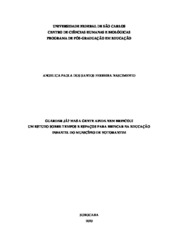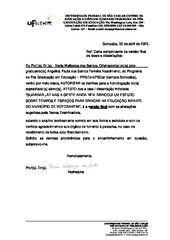| dc.contributor.author | Nascimento, Angelica Paola dos Santos Ferreira | |
| dc.date.accessioned | 2020-05-04T12:20:34Z | |
| dc.date.available | 2020-05-04T12:20:34Z | |
| dc.date.issued | 2020-02-27 | |
| dc.identifier.citation | NASCIMENTO, Angelica Paola dos Santos Ferreira. Guardar já? Mas a gente ainda nem brincou! Um estudo sobre tempos e espaços para brincar na educação infantil do município de Votorantim. 2020. Dissertação (Mestrado em Educação) – Universidade Federal de São Carlos, Sorocaba, 2020. Disponível em: https://repositorio.ufscar.br/handle/ufscar/12676. | * |
| dc.identifier.uri | https://repositorio.ufscar.br/handle/ufscar/12676 | |
| dc.description.abstract | This research investigated the times and spaces of playing in the early childhood education, whose were told by the educators from institutions of Votorantim, a country city in the state of Sao Paulo, in Brazil. Therefore, the guiding question of this study was: what importance teachers attribute to playing within the institutionalized space of early childhood education. It was based on the methodology of qualitative research, using semi-structured interviews, according to the theoretical basis of childhood studies in Brazil and also linked to studies about playing, supported by Kishimoto, Brougère and Carneiro's studies. The general objective was to understand how, where and when the times and spaces dedicated to playing take place at school, as well as whether childhood educators got the valuing of playing on their training. The choice of the theme is justified by its relevance, for the fields of Education and childhood studies, since the times and spaces of playing have decreased more and more in society (Kishimoto, 1986). Thus, as the institution of early childhood education is the environment where children have more contact between peers, to exist the playing, the times and spaces must be a driver for educational practices, grounded by teacher training that recognizes and values the specificities of childhood. | por |
| dc.description.sponsorship | Não recebi financiamento | por |
| dc.language.iso | por | por |
| dc.publisher | Universidade Federal de São Carlos | por |
| dc.rights | Attribution-NonCommercial-NoDerivs 3.0 Brazil | * |
| dc.rights.uri | http://creativecommons.org/licenses/by-nc-nd/3.0/br/ | * |
| dc.subject | Tempos e espaços - brincar | por |
| dc.subject | Formação docente | por |
| dc.subject | Educação Infantil | por |
| dc.subject | Práticas educativas | por |
| dc.subject | Infância | por |
| dc.subject | Times and spaces - playing | por |
| dc.subject | Teacher training | por |
| dc.subject | Early childhood education | por |
| dc.subject | Educational practices | por |
| dc.subject | Childhood | por |
| dc.title | Guardar já? Mas a gente ainda nem brincou! Um estudo sobre tempos e espaços para brincar na educação infantil do município de Votorantim | por |
| dc.title.alternative | Oh, no! Putting away, but already? But we haven't even played yet! A study about times and spaces of playing in the city of Votorantim. | por |
| dc.type | Dissertação | por |
| dc.contributor.advisor1 | Santos, Maria Walburga dos | |
| dc.contributor.advisor1Lattes | http://lattes.cnpq.br/2954227254025696 | por |
| dc.description.resumo | A presente pesquisa investigou os tempos e espaços para brincar na educação infantil, tendo como protagonista as palavras de educadores e educadoras em instituições de Votorantim, no interior do estado de São Paulo, Brasil. Para tanto, a questão norteadora do estudo foi: o que os professores e professoras desta rede de ensino pensam sobre os tempos e os espaços do brincar. Fundamentada em metodologia de pesquisa qualitativa, tendo como método as entrevistas semi-estruturadas, a pesquisa tem a base teórica dos estudos da infância no Brasil e está vinculada aos estudos a respeito de brincar, teoricamente respaldados por: Kishimoto, Brougère e Carneiro. O objetivo geral foi o de compreender como, onde e quando se dão nas instituições de educação infantil os tempos e os espaços dedicados ao brincar, bem como se os educadores e educadoras da infância têm em sua formação as raízes para a valorização do brincar. A escolha do tema justifica-se pela sua relevância, para os campos da Educação e dos estudos da infância, uma vez que os tempos e espaços do brincar tem diminuído cada vez mais na sociedade (Kishimoto, 1986). Sendo a instituição de educação infantil o ambiente em que mais as crianças têm contato entre os pares, é notório que para haver o brincar, os tempos e espaços devem ser propulsores para as práticas educativas, alicerçados pela formação docente que valoriza e reconhece as especificidades da infância. | por |
| dc.publisher.initials | UFSCar | por |
| dc.publisher.program | Programa de Pós-Graduação em Educação - PPGEd-So | por |
| dc.subject.cnpq | CIENCIAS HUMANAS::EDUCACAO::TOPICOS ESPECIFICOS DE EDUCACAO | por |
| dc.publisher.address | Câmpus Sorocaba | por |
| dc.contributor.authorlattes | http://lattes.cnpq.br/1606867523617086 | por |


